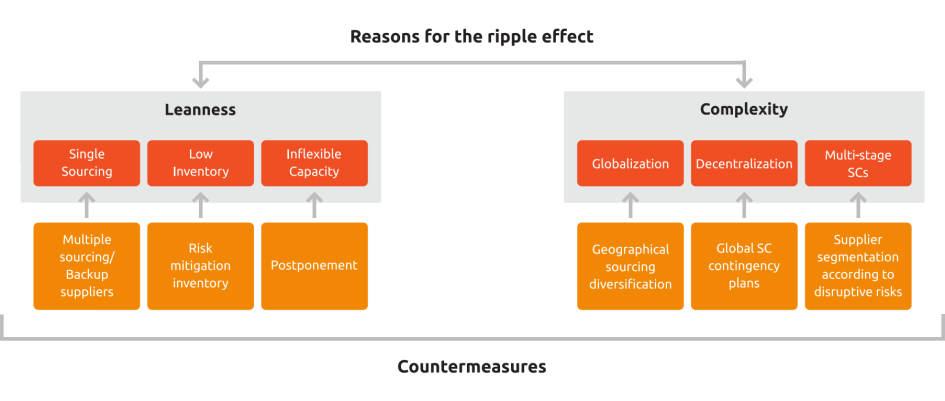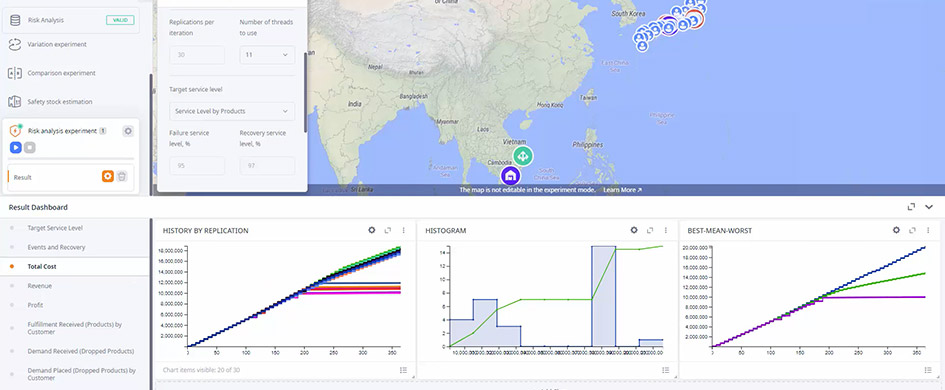
Supply chain disruption comes in many forms: from local issues such as a staff shortage or a warehouse fire, to global problems like the COVID-19 pandemic, or even events like the 2021 Suez Canal obstruction.
For supply chain managers dealing with supply disruption, the questions are:
In this article, we will answer those questions. We will look at how forecasting, planning, and the creation of mitigation strategies can all help increase supply chain robustness and develop organizational agility for when change is necessary.
While attractively economical, the tendency towards just-in-time (JIT) manufacturing has made today’s supply chains vulnerable to disruption. The approach favors narrow stock-level margins and predictable supplies with the result that the supply chain is sensitive to delays and changes to business-as-usual. In times of disruption, delivery problems can quickly impact on a company’s bottom line.
The seriousness of supply chain disruption is evident from the White House blogging why the pandemic has disrupted supply chains, to Accenture’s reporting that 94% of the Fortune 1000 are seeing supply chain disruptions from COVID-19. Supply chain disruption has even become part of popular culture.
From the @Spectator and tonight’s Evening Blend (sign up here: https://t.co/mSghAFTMTB), by @Ncknwmn pic.twitter.com/yiMtuySha5
— Spectator Cartoons (@SpecCartoons) September 2, 2021
There are three related aspects to improving the handling of supply chain disruption:
Taken together, supply chain visibility, analysis, and planning help build disruption resilience and the agility to deal with change.
Of course, it is easy to identify that visibility, analysis, and planning are important. But, building the knowledge base and skills to fully act on them may not always be so easy or straightforward. Problems begin almost immediately when you try to model a supply chain using Excel spreadsheets – as is common to most companies in supply chain.
Modeling a supply chain in Excel means losing detail and flexibility when compared to modern supply chain software tools. As a result, supply chain optimization and forecasting using Excel are also compromised – lacking the detail and flexibility to accommodate change.
Further problems with Excel relate to data visualization and the need for a dynamic view – without seeing how a supply chain behaves over time, it becomes much harder to plan effectively.
To truly tackle supply chain resilience and address the three points listed above, leading companies are turning to supply chain specific tools that allow for a new supply chain model – the digital supply chain network (DSN). These new tools can account for problems that can affect a whole supply chain, such as the ripple effect of an exceptional disruption.
Exceptional disruptions such as pandemics, floods, legal conflicts, and strikes may all be rare but their impact on supply chain performance can be high – directly impacting supply chain structure and causing knock-on implications for revenue and profit. Because of how the effects from exceptional disruptions tend to propagate throughout a supply chain, the phenomenon is known as the ripple effect. The phenomenon can have a significant effect on business and being prepared for it increases operational resilience – read more in our white paper.

Reasons for the ripple effect in supply chains and their countermeasures.
UPS warns that the supply chain crisis sparked by the COVID-19 pandemic will leave a permanent scar. The message being that supply chains are changing fundamentally as they are now prioritizing resilience and flexibility. To deliver these supply chain attributes, Accenture says the response should be technology led while Deloitte also suggests managing supply chain risk and disruption with new supply chain technologies.
The supply chain tools now available go beyond Excel. They are user friendly and offer an experience tailored to supply chain that captures data end-to-end, they give clear and dynamic insights into operations, and assist in planning with experiments and simulation. Using a modern supply chain tool, it is possible to more easily understand a supply chain’s status, identify risks, and plan for different scenarios.
Now is the time to leverage the supply chain technologies on offer and develop the supply chain you need in these fast-changing times.
Dynamic simulation and analytical optimization are the two main technologies giving organizations the opportunity to tackle risk management in supply chain. These technologies provide context and insight into disruptions and enable better responses through the testing of plans and the development of policy.
Simulation models are useful for studying how models operate over time. They describe interactions in a network as in real life so that operations can be viewed dynamically and in detail. It is an approach that can consider constraints such as inventory, production, sourcing, and shipment control policies, as well as capacity degradation and recovery over time. Because it captures finer detail, the simulation approach enables the development of operational strategies for managing supply chain disruptions.
In this video about using simulation for risk analysis in supply chain, you can see the affects of unexpected disruptions.

Optimization models help evaluate the introduction of redundancies, such as backup suppliers, reserve capacity, and risk mitigation inventory. The results can inform network topology development – increasing resilience to disruption by enabling quick reaction and recovery. Typically, the approach is used at a strategic decision-making level.
As simulation and optimization are proving, now is a great time to appraise your supply chain and see how new approaches can help better meet the fast-changing demands of today’s supply chains.
To learn more about managing supply chain disruption, the ripple effect, and how simulation and optimization help develop supply chain resilience, we have a white paper from supply chain expert Prof. Dr. Habil. Dr. Dmitry Ivanov, SCD. In the paper, you will also find a methodology for minimizing the ripple effect through the creation of a digital twin and the use of simulation and optimization.